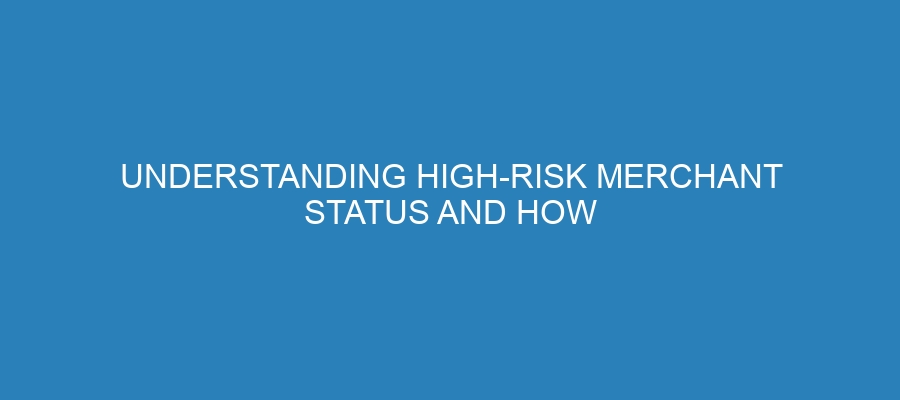Are you a business owner struggling with the complexities of high-risk merchant status? You’re not alone! Many businesses, ranging from online apparel shops to niche subscription services, face the daunting task of managing their merchant account due to perceived risks. If you’re asking yourself, “Why is my merchant status high-risk?” or “What can I do to manage it?” this article is for you. Grab a cup of coffee, because we’re diving deep into the world of high-risk merchant accounts and how you can navigate the stormy waters of this often frustrating landscape.
What Is High-Risk Merchant Status?
First, let’s define what we mean by “high-risk merchant.” Essentially, a high-risk merchant account is one that comes with higher fees, stricter terms, and elevated scrutiny compared to standard merchant accounts. Businesses classified as high-risk are typically those that operate in industries deemed risky by banks and payment processors.
Industries Commonly Considered High-Risk:
- E-commerce Stores: Especially those selling items like supplements or adult products.
- Travel Agencies: This includes any form of bookings or ticketing services.
- Subscription Services: Whether it’s niche magazines or curated food boxes.
- Online Gambling: Even in regions where it’s legal, the risk remains high.
- Adult Entertainment: Think adult films, chat services, or websites.
Why Do Banks and Processors Label Businesses as High-Risk?
Understanding why your business has been labeled as high-risk can be crucial for managing your financial future. Here are some factors that contribute to this label:
Fraud Rates
Businesses in high-risk industries may experience higher rates of chargebacks or fraud, leading processors to increase scrutiny. This is particularly important for online transactions where there is less personal interaction.
Regulatory Issues
Specific industries have more regulations than others. For example, the legal landscape surrounding online gambling is constantly changing, leading to increased complexity.
Chargeback Frequency
If your business has had a high number of chargebacks in the past, it may lead to being labeled high-risk. Banks are cautious and could view frequent chargebacks as a lack of consumer satisfaction.
Product Type
Selling high-value or high-cost items can also label you as a high-risk merchant since those often come with a higher risk of fraud or chargebacks.
Managing Your High-Risk Status
Understanding why you’re considered a high-risk merchant is just the beginning. Now, let’s explore how you can manage this status effectively. Here are some tips:
1. Choose the Right Payment Processor
Not all payment processors cater to high-risk businesses. Choosing one that specializes in high-risk accounts can save you from headaches down the line. Companies like Payment Cloud specialize in providing solutions tailored to high-risk industries, ensuring you get the support needed.
2. Keep Chargebacks to a Minimum
Implement strategies to minimize chargebacks. This can include better customer service, clear product descriptions, and easy return policies. Keeping customers happy can reduce the likelihood they’ll file a chargeback.
3. Maintain Clear Communication
Always keep lines of communication open with your processor. Make sure your merchant account details, including any changes in your practices or business model, are transparently communicated to avoid surprises.
4. Build a Strong Online Presence
Establishing trust online can help alleviate concerns from both customers and payment processors. Strong online reviews, a professional website, and engaging content can significantly strengthen your merchant profile.
5. Provide Comprehensive Fraud Protection
Utilize software and tools that help you identify and prevent fraudulent transactions. Well-established security protocols can build confidence, not just with payment processors but with your customers too.
6. Diversify Payment Methods
Offering multiple payment methods can not only attract more customers but also spread your risk. If one avenue is flagged, you can continue to operate via others.
FAQs About High-Risk Merchant Status
Q1: How does a business get labeled as high-risk?
A1: A business may be labeled high-risk due to its industry, chargeback history, product/service type, or regulatory challenges.
Q2: Can a high-risk merchant eventually attain a standard merchant status?
A2: Yes, with improved practices and a good track record, businesses can eventually transition to a standard merchant status.
Q3: Are high-risk merchant accounts significantly more expensive?
A3: Generally, yes. High-risk merchant accounts may come with higher fees and stricter terms than standard accounts, but this can vary based on the provider.
Q4: Can high-risk merchants accept payments online?
A4: Absolutely! Many high-risk payment processors specifically cater to online transactions, ensuring that you can operate your e-commerce business smoothly.
Q5: Will being high-risk affect my customer’s experience?
A5: Not necessarily. While it may come with challenges on the backend, focusing on excellent customer service can minimize the impact on your customer’s experience.
Conclusion
In today’s competitive environment, navigating the complexities of high-risk merchant status can be daunting. However, understanding your status and employing strategies to manage it can help bring you peace of mind. Always remember that you are not alone in this journey. If you find the landscape overwhelming or if you simply want guidance on switching payment processors, it is worth reaching out to experts who can help.
For tailored assistance in managing your high-risk merchant account, consider contacting Payminate.com. They specialize in helping businesses like yours overcome challenges and succeed. Don’t let high-risk status hold you back from reaching your full potential!

